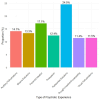Lifetime prevalence of psychotic experience, and its associated factors among Senegalese women: a cross-sectional study
- PMID: 40295938
- PMCID: PMC12039068
- DOI: 10.1186/s12888-025-06879-0
Lifetime prevalence of psychotic experience, and its associated factors among Senegalese women: a cross-sectional study
Abstract
Background: Psychotic experiences, which include a range of symptoms such as delusions and hallucinations, is an indication of elevated risk for mental disorders and poor quality of life. These experiences are often underreported and undertreated in low- and middle-income countries, including Senegal. This study aimed to investigate the lifetime prevalence of psychotic experience, its associated factors and adverse outcomes among Senegalese women.
Methods: This study analyzed the 2023 demographic and health survey data of 16,521 Senegalese women. Descriptive analysis, cross-tabulations, chi-square test, and binary logistic regression models were computed in STATA 18. The multivariable logistic regression analysis followed a backward stepwise approach.
Results: Overall, 6,819 women (41.3% [95%CI: 38.4-44.2]) had a lifetime prevalence of psychotic experience. Referential delusions were the most prevalent (24.5%), followed by paranoid ideation (17.1%), auditory hallucinations (14.1%), bizarre delusions (13.3%), possession (12.4%), visual hallucinations (11.5%), and thought insertion/broadcasting (11.4%). The odds of psychotic experience increased consistently with age. Higher educational attainment (AOR = 0.73, 95%CI: 0.61-0.88) and being currently in union were associated with lower odds of psychotic experiences (AOR = 0.90, 95%CI: 0.81-0.99). A higher risk of psychotic experience was found among women who were exposed to media (AOR = 1.08, 95%CI: 1.00-1.17), those in the richest wealth index (AOR = 2.33, 95%CI: 2.06-2.63), and currently employed women (AOR = 1.21, 95%CI: 1.12-1.30). Dietary habits were relevant, as consuming fried and processed food (AOR = 1.25, 95%CI: 1.15-1.37) and soda and energy drinks (AOR = 1.14, 95%CI: 1.03-1.27) were both associated with increased odds of psychotic experiences. Women who reported a lifetime prevalence of psychotic experience were significantly more likely to attempt suicide (AOR = 10.89; 95%CI: 7.10-16.72), anxiety (AOR = 4.64; 95%CI: 3.89-5.52), and depression (AOR = 7.39; 95%CI: 5.14-10.62).
Conclusion: In conclusion, four out of ten women in Senegal had a lifetime prevalence of psychotic experience. These experiences increase the likelihood of anxiety, depression and suicidal attempts. We also conclude that psychotic experiences are associated with sociodemographic and lifestyle factors including age, educational level, employment status, media exposure and dietary habits. Interventions to reduce psychotic experiences should focus on education, media exposure, employment, and dietary habits.
Keywords: Epidemiology; Mental health; Psychiatry; Psychotic experience; Public health.
© 2025. The Author(s).
Conflict of interest statement
Declarations. Ethical approval and consent to participate: We did not need to seek ethical clearance because the DHS dataset we used is publicly available. We obtained the datasets from the DHS Program after completing the necessary registration and getting approval for their use. We followed all the ethical guidelines that pertain to using secondary datasets in research publications. You can find detailed information about how we used the DHS data and the ethical standards we followed at this link: http://goo.gl/ny8T6X . Consent for publication: Not applicable. Competing interests: The authors declare no competing interests.
Figures
Similar articles
-
Psychotic Experiences in the General Population: A Cross-National Analysis Based on 31,261 Respondents From 18 Countries.JAMA Psychiatry. 2015 Jul;72(7):697-705. doi: 10.1001/jamapsychiatry.2015.0575. JAMA Psychiatry. 2015. PMID: 26018466 Free PMC article.
-
Depression moderates the relationships between hallucinations, delusions, and suicidal ideation: The cumulative effect of experiencing both hallucinations and delusions.J Psychiatr Res. 2019 Sep;116:166-171. doi: 10.1016/j.jpsychires.2019.06.014. Epub 2019 Jun 18. J Psychiatr Res. 2019. PMID: 31255908
-
Psychotic experiences and disability: Findings from the Collaborative Psychiatric Epidemiology Surveys.Schizophr Res. 2018 Mar;193:343-347. doi: 10.1016/j.schres.2017.07.049. Epub 2017 Aug 7. Schizophr Res. 2018. PMID: 28797526 Free PMC article.
-
Lifetime prevalence of psychotic-like experiences and associated factors in Chile.Soc Psychiatry Psychiatr Epidemiol. 2025 Feb;60(2):329-339. doi: 10.1007/s00127-024-02741-y. Epub 2024 Jul 27. Soc Psychiatry Psychiatr Epidemiol. 2025. PMID: 39066802
-
Substance use and sociodemographic background as risk factors for lifetime psychotic experiences in a non-clinical sample.J Subst Abuse Treat. 2017 Mar;74:42-47. doi: 10.1016/j.jsat.2016.12.007. Epub 2016 Dec 29. J Subst Abuse Treat. 2017. PMID: 28132699
References
-
- Calabrese J, Khalili Y, Al. Psychosis. StatPearls. 2023.
MeSH terms
LinkOut - more resources
Full Text Sources
Medical


